
量子效率测试仪
PL/EL一体机
Sinton硅片少子寿命测试仪
Sinton硅块少子寿命测试仪
绒面反射率测试仪
3D共聚焦显微镜
清洗制绒工作站
在线四探针方阻测试仪
全自动扫描四探针方阻测试仪
在线薄膜厚度测试仪
晶化率测试仪
Horiba显微共焦拉曼光谱仪
傅里叶红外光谱仪
霍尔效应测试仪
分光光度计
全光谱椭偏仪
Horiba椭圆偏振光谱仪
TLM接触电阻率测试仪
超景深显微镜
网版智能影像测量仪
全自动影像测量仪
卧式拉力机
电池片稳态光衰老化试验箱
电池片紫外老化试验箱
电池片拉脱力综合测试仪
外观检验台
湿漏电测试系统
组件实验室EL测试仪
紫外老化试验箱
稳态光衰老化试验箱
电流连续性监测系统
PID测试系统
旁路二极管测试系统
LeTID测试系统
反向电流过载系统
脉冲电压测试系统
绝缘耐压测试仪
接地连续性测试仪
绝缘耐压接地测试仪
湿热环境试验箱
湿冻环境试验箱
热循环试验箱
动态机械载荷测试机
静态机械载荷测试机
冰雹冲击试验机
引出端强度试验机
霰弹冲击试验机
抗划伤(切割)测试机
剥离试验机
万能材料试验机(单臂)
万能材料试验机(双臂)
光伏玻璃透过率测试仪
醋酸测试试验箱
交联度测试系统
二极管接线盒综合测试仪
落球冲击试验机
半自动四探针
全自动探针式台阶仪
多通道太阳能MPPT系统
Horiba稳瞬态荧光光谱仪
钙钛矿P1激光划线测试仪
钙钛矿在线膜厚测试仪
钙钛矿工艺检测工作站
手持式IV测试仪
便携式EL测试仪
手持热成像测试仪
户外组件IV测试仪
户外组件多通道测试系统
光伏逆变器电能质量测试仪
无人机EL检测仪
迈向27.51%效率,非晶/微晶材料在HBC太阳能电池中的应用
日期:2024-11-13浏览量:25
太阳能光伏行业正寻求通过创新制造工艺、新型材料、太阳能电池设计和模块配置来提高模块性能。SHJ 太阳能电池具高 PCE、简化制造工艺和低制造成温等优点,但存在Jsc较低和原材料成本较高等局限,IBC技术有望提升硅太阳能电池PCE。SHJ太阳能电池利用非晶硅层进行有效钝化,并通过掺杂的非晶硅层形成钝化接触。
SHJ太阳能电池和SHJ-IBC太阳能电池
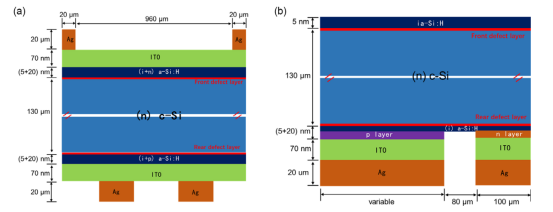
两种太阳能电池的结构示意图
SHJ太阳能电池结构
从上到下的结构依次为:银/ITO/(n+i)层/(n) c-Si/(i+p)层/ITO/银。
其中,银(Ag)作为电极材料,ITO(氧化铟锡)作为透明导电氧化物层。
(n+i)层表示n型掺杂的非晶硅层与本征非晶硅层的组合,(n) c-Si表示n型掺杂的晶体硅层,(i+p)层表示本征非晶硅层与p型掺杂的非晶硅层的组合。
这种结构利用非晶硅层进行有效钝化,并通过掺杂的非晶硅层形成钝化接触,以提高电池的效率。
SHJ-IBC太阳能电池结构
SHJ-IBC太阳能电池在结构上与SHJ太阳能电池类似,但具有一些关键区别。
在SHJ-IBC太阳能电池中,电子选择性接触(ESC)和空穴选择性接触(HSC)都位于电池的背面,这有助于减少前表面的遮挡,提高光的利用率。
电池背面分为三个区域:ESC、HSC和一个分隔它们的间隙。
这种设计旨在减少由于电极阴影效应导致的效率损失,同时提高电池的填充因子(FF)和功率转换效率(PCE)。
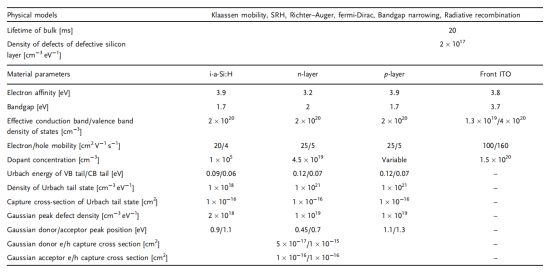
数字孪生中使用的参数
这些参数对于准确模拟SHJ太阳能电池的性能至关重要,因为它们影响载流子的传输、复合和电池的整体效率。通过精确设置这些参数,研究人员可以创建出能够准确反映实际电池性能的数字孪生体,进而评估和优化电池设计。
接触电阻模拟
评估具有非晶硅(p-a-Si:H)和纳米晶硅(p-nc-Si:H)空穴选择性接触(HSC)层的SHJ太阳能电池在最大功率点(MPP)的功率损失。
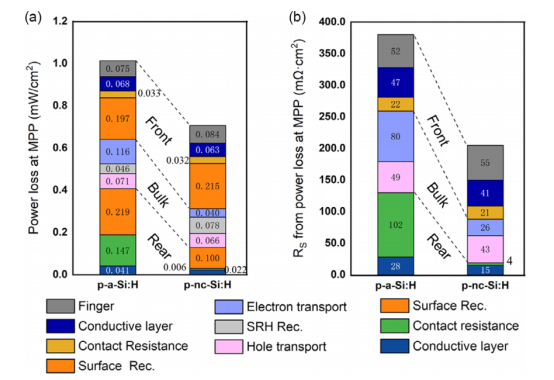
SHJ太阳能电池在最大功率点(MPP)的功率损失和系列电阻的分析
功率损耗分析:
对比了具有 p - a - Si:H 空穴选择接触(HSC)层和 p - nc - Si:H HSC 层的 SHJ 太阳能电池在最大功率点处的功率损耗情况,表明电池性能增强主要源于背面 HSC 层。
串联电阻构成:
将 Rs 分解为多个组成部分,包括体相内部的本征成分、前后表面透明导电氧化物(TCO)和电极指区域的载流子传输电阻以及电子选择接触(ESC)和 HSC 的接触电阻率(ρESC 和 ρHSC)。
图中可看出 ρESC 虽略有降低但变化不大,而 ρHSC 从 102 降至 4mΩ cm²,显著减小,这表明在提升电池性能方面,降低 HSC 层接触电阻率具有重要意义。
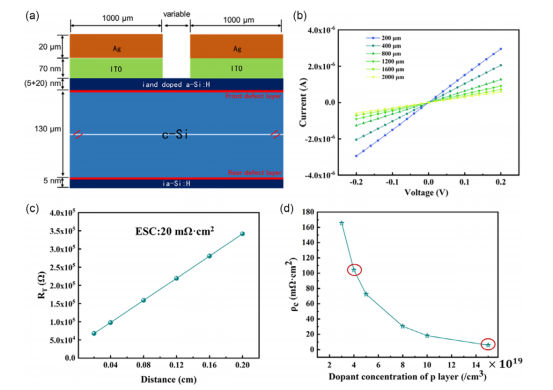
SHJ太阳能电池接触电阻率(ρC)模拟
TLM模拟结构示意图:这个结构包括两个相同的接触堆叠,每个宽度为1000微米,位于c-Si基底上,并通过可变间隙隔开。
J-V特性曲线:在暗条件下(电压范围为-0.2至0.2伏特)对不同接触垫间距的电子选择性接触(ESC)进行评估的J-V(电流-电压)特性曲线。这些曲线用于计算接触电阻率ρC。
不同接触垫间距的总电阻RT:不同接触垫间距下ESC的总电阻RT,这些数据用于通过TLM方法计算接触电阻率ρC。
接触电阻率ρC的计算:图中可以计算接触电阻率ρC,使用公式ρC = RC - LT / W,其中RC是接触电阻的一半,LT是有效转移长度的一半,W是TLM模拟中默认的接触长度(1微米)。
掺杂浓度对接触电阻率的影响:通过TLM模拟确定的p层的掺杂浓度,图中突出显示了p-a-Si:H HSC和p-nc-Si:H HSC的点。通过增加掺杂浓度,可以显著降低ρHSC。
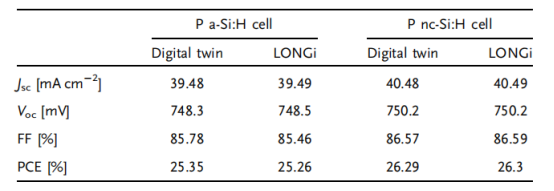
SHJ太阳能电池数字孪生体的电气性能比较
短路电流(Jsc):使用p-nc-Si:H HSC的太阳能电池的Jsc略高于使用p-a-Si:H HSC的电池,这表明纳米晶硅层可以提高电池的短路电流。
开路电压(Voc):p-nc-Si:H HSC的太阳能电池的Voc也略高于p-a-Si:H HSC的电池,这可能是由于纳米晶硅层更好的载流子选择性,减少了载流子的复合损失。
填充因子(FF):p-nc-Si:H HSC的太阳能电池的FF同样略高于p-a-Si:H HSC的电池,这表明纳米晶硅层可以提高电池的整体性能。
功率转换效率(PCE):p-nc-Si:H HSC的太阳能电池的PCE高于p-a-Si:H HSC的电池,这与Jsc、Voc和FF的提高相一致。
与LONGi太阳能电池的比较:数字孪生体的模拟结果与LONGi公司的实验结果非常接近,这验证了数字孪生体模型的准确性和可靠性。
使用纳米晶硅(p-nc-Si:H)作为HSC层的SHJ太阳能电池在电气性能上优于使用非晶硅(p-a-Si:H)的电池。
SHJ和SHJ-IBC太阳能电池的数字孪生体创建
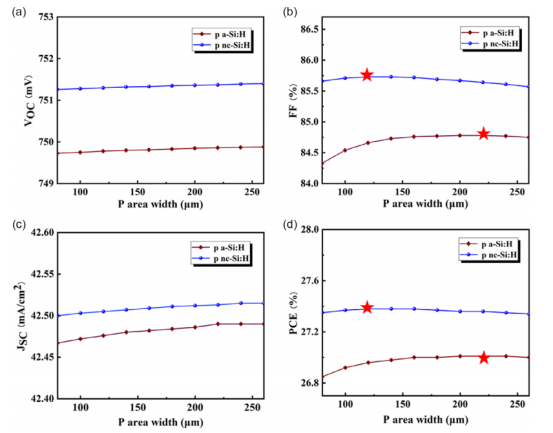
SHJ-IBC太阳能电池的电气性能
HSC宽度与VOC的关系:
随着HSC宽度的增加,开路电压(VOC)提高。使用p-nc-Si:H HSC的电池相比使用p-a-Si:H HSC的电池展现出更高的VOC,这归因于p-nc-Si:H更高的掺杂浓度,导致在c-Si中的能带弯曲更强,复合损失减少。
HSC宽度与FF的关系:
填充因子(FF)随着HSC宽度的增加而提高。
p-nc-Si:H HSC的电池由于其更高的载流子收集能力,相比p-a-Si:H HSC的电池展现出更高的FF。
HSC宽度与JSC的关系:
短路电流(JSC)随着HSC宽度的增加而提高。
减少的复合损失和增强的载流子收集能力有助于提升JSC。
HSC宽度与PCE的关系:
功率转换效率(PCE)随着HSC宽度的增加而提高,但存在一个最佳点,超过这个宽度后效率会开始下降。
对于使用p-a-Si:H HSC的SHJ-IBC电池,当HSC宽度为220微米时,PCE达到27.01%。对于使用p-nc-Si:H HSC的SHJ-IBC电池,当HSC宽度为120微米时,PCE达到27.38%。
当将间隙宽度从80微米减少到20微米时,p-nc-Si:H HSC的电池的PCE可以进一步提升到27.51%。

短路电流(JSC):三种情况下的JSC都接近42.5 mA cm^-2,表明光生电流密度在不同设计间保持一致。
开路电压(VOC):使用纳米晶硅(nc-Si:H)HSC的电池展现出比非晶硅(a-Si:H)HSC的电池更高的VOC。将间隙宽度从80微米减少到20微米,进一步略微提高了使用nc-Si:H HSC的电池的VOC。
填充因子(FF):使用nc-Si:H HSC的电池展现出比使用a-Si:H HSC的电池更高的FF。
减少间隙宽度进一步提高了使用nc-Si:H HSC的电池的FF。
功率转换效率(PCE):
使用a-Si:H HSC的电池的PCE为27.01%。
使用nc-Si:H HSC的电池的PCE为27.38%。
将间隙宽度从80微米减少到20微米,将使用nc-Si:H HSC的电池的PCE提高到27.51%。
通过创建高效硅异质结(SHJ)太阳能电池的数字孪生模型,评估了 SHJ - IBC太阳能电池的实际效率极限,SHJ - IBC 电池采用非晶 HSC 效率可达 27.01%,纳米晶 HSC 时可达 27.38%,将间隙宽度从80μm减至20μm可使效率提升至 27.51%。
联系电话:400 008 6690
美能晶化率测试仪拥有极佳的紫外灵敏度和优异的光谱重复性。采用325激光器,同时优化紫外光路设计,提高光谱稳定性,高效率利用325激光与样品拉曼信号,实现了5nm以上非晶/微晶材料的原位测试,是表征"微晶一异质结"电池的最优选择。
n行业最佳,紫外灵敏度硅一阶峰的信号计数优于1000 (1秒积分时间)
n光谱重复性:单晶硅校准后,≤520±0.02cm-1
n光栅刻线数:≤2400 gr/mm;≤1800 gr/mm
随着非晶/微晶材料在HBC太阳能电池中的关键作用日益凸显,美能晶化率测试仪以其卓越的紫外灵敏度和光谱重复性,成为了这一领域不可或缺的工具。该测试仪采用的325纳米激光器和优化的紫外光路设计,不仅提高了光谱稳定性,还实现了对5nm以上非晶/微晶材料的原位测试,为“微晶-异质结”电池的表征提供了强有力的技术支持。
原文出处:Evaluating the Practical Efficiency Limit of Silicon Heterojunction–Interdigitated Back Contact Solar Cells by Creating Digital Twins of Silicon Heterojunction Solar Cells with Amorphous Silicon and Nanocrystalline Silicon Hole Contact Layers




































































